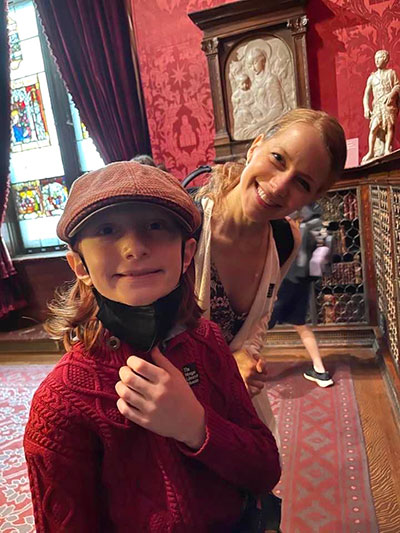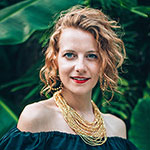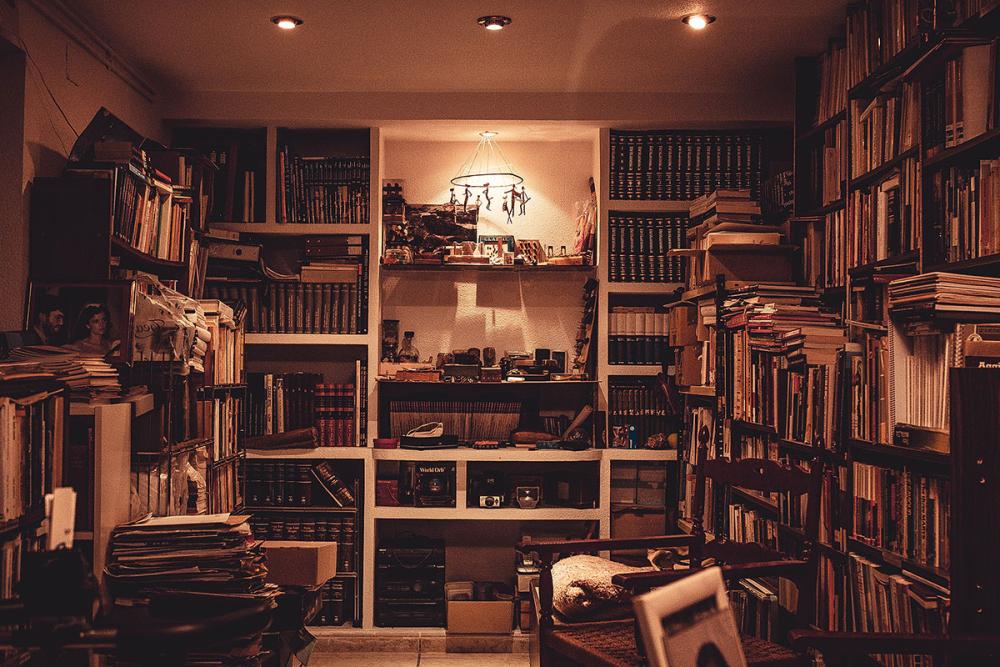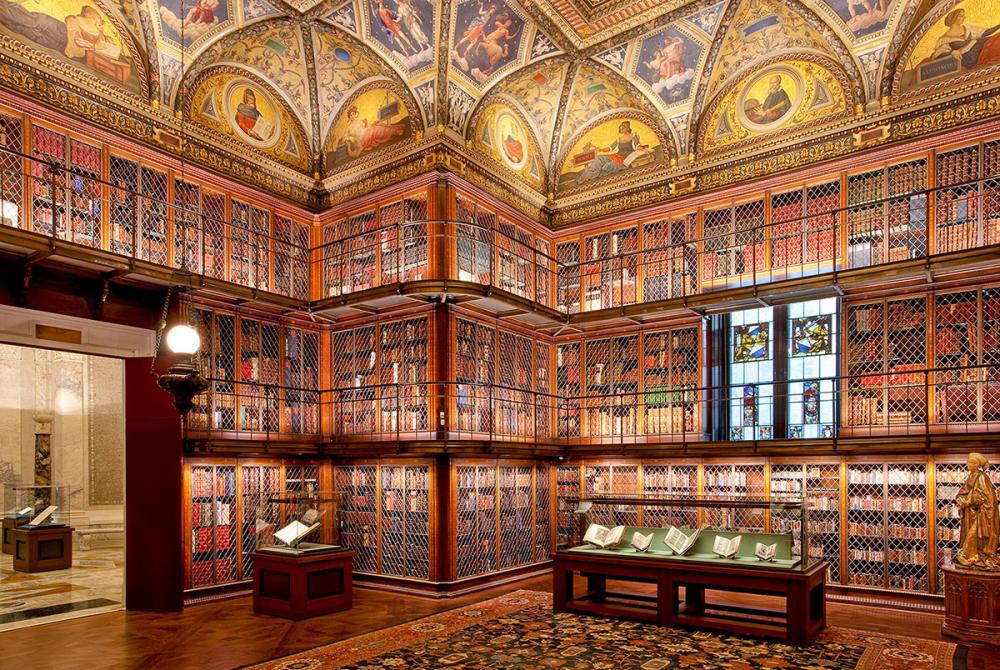This is a guest post by Cassandra McLean Pereira, artist, writer, and editor.
“The library is a room that… reflects our relationship with knowledge… Because knowledge is like anything — when you love it, you want to do something for it. Sometimes you want to build it a beautiful room.”
— Akiko Busch, Geography of Home
The Home Library: A Unique Place
To create one’s own library is the natural impulse of devoted bibliophiles and lukewarm intellectuals alike. Whether it’s a single bookshelf above a desk, or a dedicated room in a grand mansion, the home library evokes a distinct mood.
Independent of their contents, the mere presence of books stimulates our appetite for learning. It inspires intellectual confidence and humility simultaneously; as a consequence of this tension, it sparks creativity.
How exactly does the aesthetic of the home library accomplish all this?
I’ve often wondered, (reposed against a backdrop of my own books.) But it wasn’t until immersing myself in the actualized, architectural archetype of “the home library,” J. Pierpont Morgan's Library, that I experienced the answer.
The Symbolic Mirror of Books Kept
A person’s home library is a mirror that reflects to them and others a multifaceted and dynamic individuality.
Unlike public libraries, which are curated and designed to meet the needs of a community, home libraries are always intimate extensions of the individuals who create them. Just as my library began long ago as a tender attachment to the books I was raised on, most home libraries are accumulative, lifelong endeavors, growing as we do, showing us not only our interests and values, but more broadly who we are, who we were, and who we might become.
As symbols, the books we keep and care for tether our sense of self to the ideas and knowledge they contain. To see them is to see our interests and values reflected back to us, and because this image is controllable, it is comforting. For example, ownership of Wittgenstein reflects someone who is, or at least wishes to be, philosophical and inquisitive. Romance novels, on the other hand, reveal an esteem for the amorous.
The books in our personal libraries also signify our connectedness with people. Firstly: past, present and future versions of ourselves. The books we’ve read hold memories of who we were when we read them, while the books we haven’t read yet contain who we might become if we do. (We keep these potentialities literally within arm’s reach.) Secondly, our kept books connect us to their authors: Memoirs on our bookshelves, for example, narrow the distance between our simple lives and the lives of heroes and history makers. Thirdly, the books we own are signals of relatedness with other readers. Consider, for example, visiting someone’s house for the first time and finding your favorite book on their mantlepiece.
Most interestingly, books are abstractions—thoughts, ideas, imaginary worlds—in concrete form. As such, books are physical bonds that prove the human being’s dual-occupancy of a physical reality and a metaphysical reality. To own books, to cherish them, is to acknowledge and to honor this dual-natured existence of ours.
A Sacred Creation of Self-Expression
Over the years, other personal objects tend to find their place among our kept books: Paintings and pictures, gifts from friends, gemstones and geodes, shells, plants, candles, statues, travel souvenirs; relics of near and distant pasts; objects that emanate a secret sacredness.
The secular person’s bookshelf becomes analogous to the spiritual person’s altar: A special place inside the home that cues attention inward, to the realm of thought and feeling. The home library, however big or small, is an unambiguous representation of, and invitation into, the mind externalized.
Holding Space: The Library Aesthetic and Its Visual Impact
For such precious objects, the space we hold them in is equally precious. More than a pleasing presentation, the library is an aggregate of unspoken codes and symbolism. Be it a wall, a room, or a building full of books, the library communicates principally as a visual language upon which merely gazing can alter our moods. The bigger and richer the space, the more deeply it affects us. The effect is humbling, meditative, and inspiring.
The library aesthetic is often characterized by a harmony of warm, muted colors, soft lighting, dark wood, and a faint aroma of aging paper. Its soundscape is silence, appropriately: If aesthetics are visual language, to look at them is to listen. While this space is fundamentally a container for books—the ultimate symbol of the power of written language—as a visual language, the library aesthetic invites us to think as we see, merging perception with introspection.
Inside of a lavish library, like J. Pierpont Morgan's Library, you can see with your eyes the enormous scope and real weight of collective human intelligence. (The competence; the imagination; the artistry!) This visual shock quiets your mind, trancelike. The relative insignificance of whatever you might personally contribute here is apparent, and this gives you a feeling of relief. Paradoxically, to be emptied of ego is nourishing; creativity awakens.
Considering now the power of this place, imagine you had unlimited resources and the chance to build the library of your dreams. What would you collect? How would you organize and display your collection? How would you design the perfect space to hold you in sacred togetherness with these extraordinary artifacts?
At the turn of the twentieth century, these questions weren’t a matter of daydream for J. Pierpont Morgan. They were a matter of necessity.
The Morgan: A Public, Private Library
In 1901, J. Pierpont Morgan created the world’s first billion-dollar company. One of the most formidable men of the American Gilded Age, he was also well-educated, erudite and cultured, and he took great pride in his ever-expanding collection of rare manuscripts, books, drawings, prints, and other artistic and literary treasures. In 1902, he began building one perfect place to house them all, a building adjacent to his Madison Avenue brownstone.
In the institution’s own words: “Morgan conceived of his library as… a structure that proclaimed the nature and importance of its contents, majestic in design yet intimate in scale.” Money was no object, and Morgan held back on nothing, working with the best architects of his time to actualize the library aesthetic into a consummate archetype. If the average home library is akin to an altar, J. Pierpont Morgan's Library is a cathedral.
Intended as his private home library, this majestic “mirror” reflects a person of tremendous importance: not just a steely financier and business magnate, but a complex genius who prized wisdom, art, philosophy, science and history; not just a collector, but a protector of the treasures that these scholarly pursuits yield.
Following his death, J.P. Morgan Jr. transformed his father’s private library into a public institution. As such, the Morgan Library—arguably the most magnificent home library ever created—is today accessible to anyone with the means to cover a reasonable entry fee.
The Value of The Visit: A Transformative Aesthetic Experience
Blurring the distinction between private and public space, the Morgan invites anyone to experience what can only be described as the pinnacle of a "home library." The Beaux Arts architecture, with all its gilded ornamentations, the invaluable collections, and an impeccable atmosphere synergize to create an environment that enchants its visitors to surrender to what the philosopher John Dewey called a transformative aesthetic encounter.
According to Dewey, when we become deeply immersed in any aesthetic experience, it has a transformative power to evoke emotions, broaden perspectives, and spark creative thinking and personal growth. Given the inherent symbolism and significance of books and libraries, the power of this particular encounter is potent to the point of hierophanic.
Thus, our surrender to it comes easily. If knowledge is power, the library is a fortress. Inside of walls fortified by books, we are safe to surrender, to rest, to listen. Standing before an immensity of intellectual achievements, curated by a legendary figure and arranged wondrously all around us, we surrender to awe.
Creativity Is a Consequence
A majestic mirror. A sapio-secular cathedral. A fortress. Stepping into this place is humbling. Stepping through it is invigorating!
On the other side of a transformative aesthetic encounter, we find ourselves inspired, stirred, motivated to create, tingling with a desire to contribute anything at all to the coffers of our high-minded species.
This is what happened to me, the last time I visited the Morgan Library & Museum.
A Creative Writing Exercise
In the company of my friend, poet Alison Hurwitz, and her bright-eyed son Zemeri, I designed the following activity, which I invite you to try on your next visit to the Morgan:
- Carry a notepad and pen with you
- Peruse the shelves and write down your favorite book titles
- Later, write a poem that incorporates these titles
It was my resultant poem, shared below, that initiated the above analytical meditation on the magic of the home library.
An Afternoon At The Morgan Library
By Cassandra McLean Pereira
For Alison and Zemeri
There is no space for walls, they’re all bookcases here,
of warm walnut wood, in balconied tiers,
and over these stories, held intimately,
the ceiling is lambent with iconography.
In this Eden we lose ourselves gladly all day,
among works of great literature, verse, prose and plays,
letters, riddles, and nursery rhymes,
long-gone Famous Men of Modern Times,
Fables of Flowers, poetry and hymns,
Puzzles for The Curious Child's whims,
collections, Pictures of Birds and Beasts,
a whole shelf of Voltaire’s philosophy,
Divine Songs; To Be Read at Dusk,
(or anytime, really. Reading’s a must!)
We find Anecdotes of the Animal Kingdom
in precious jeweled bindings, charming and winsome,
illuminated manuscripts, Renaissance wisdom,
Medieval adventures, A Catechism,
atlas and alphabet and almanac pages,
Quizzical Characters, tales of the ages,
Pagan Revels and Village Parables,
epics in cuneiform, Gutenberg Bibles,
Wonders of Geology; The Ancient Testament,
compendiums, anthologies, safeguarded sentiments,
Sublime Ideas, memories, An Entrance to the Mind,
Shakespeare’s first folios, knowledge of all kind
in volumes and guides from worlds near and far,
between paintings and treasures and beaux objets d’art.
What a gift, what a pleasure, a booklovers’ panoply;
the day we strolled at our leisure through the Morgan Library.

Author Cassandra McLean Pereira and fellow bibliophile Zemeri H.
 Cassandra McLean Pereira is a writer, editor, artist and musician who endeavors to foster peace and joy through creativity and contemplation. She is currently pursuing a diploma in clinical hypnotherapy at the Institute for Interpersonal Hypnotherapy. She can be found @artingdarling across social platforms.
Cassandra McLean Pereira is a writer, editor, artist and musician who endeavors to foster peace and joy through creativity and contemplation. She is currently pursuing a diploma in clinical hypnotherapy at the Institute for Interpersonal Hypnotherapy. She can be found @artingdarling across social platforms.


